A Neglected Classic from the Golden Age of Sword & Sorcery: H. Warner Munn’s Merlin Cycle
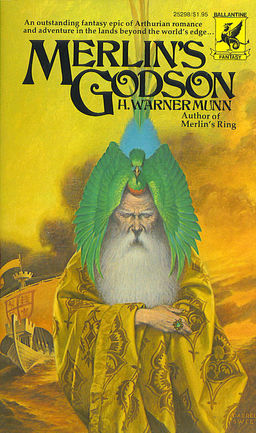 I first encountered H. Warner Munn by chance. Or maybe he encountered me, and it was more than pure chance.
I first encountered H. Warner Munn by chance. Or maybe he encountered me, and it was more than pure chance.
I started reading fantasy and science fiction in high school, when a friend recommended Anne McCaffrey’s Dragonflight books. I dutifully took the first one out of the public library and soldiered through it. I was impressed enough to decide to start broadening my narrow literary horizons. The problem was that, in South Africa in the 1980’s, the big book sellers stocked a pretty limited selection of genre titles, and the more specialized sellers were few and far between.
The solution was for my friend Graham and I to take a bus to the city center after school, and explore some of the independent and more specialized shops. One in particular has a vast array of genre books, and to this day I lament its eventual closure.
I encountered a myriad of unknown authors and works on that shop’s shelves. One that particularly intrigued me – although not enough to part with my pitifully small amount of cash – was The Misplaced Legion, by Harry Turtledove. I never saw that book on the shelves again.
Fast forward a decade and a bit and, lo and behold, the internet was here and much exploring was done. I dredged my memory — while whittling away at my employer’s internet bandwidth — looking for bits and pieces to fill out my book and RPG collections. Memory failed me somewhat, however, and when I attempted to recall that vague, impressive book from the ‘80s, I remembered it as… The Lost Legion. I no longer had a clue to the author’s name, either.
An online search quickly revealed a likely candidate titled The Lost Legion, by H Warner Munn. Needless to say, it was long out of print and Amazon and other sources revealed nothing.
Then came eBay. I quickly got over my initial skepticism and some early bad experiences, and started spending money. I wouldn’t say a lot, but for sure the eBay bug did bite (or byte?) and I joined the ranks of the millions who inspired the Weird Al Yankovic song “I Bought it on eBay.”
The only problem was The Lost Legion almost never came up, and when it did it was vastly expensive. It still is! Fortunately, my sparse knowledge of the subject led me to an alternative book by the same author called King of the World’s Edge, which I mistakenly believed to be book one of The Lost Legion, which in turn appeared to be an omnibus.
I was wrong on both accounts. But as I say, I was fortunate.
King of the World’s Edge – by H. Warner Munn
The book duly arrived from the USA. I had splashed for the cheapest copy I could find, an Ace Paperback, and it did not disappoint. Aged and worn, I was surprised to find all pages present and still attached to the spine.
By this time I had learned of a sequel, The Ship From Atlantis, and I decided to get it before I read the first book. So King of the World’s Edge was temporarily consigned to my book shelf.
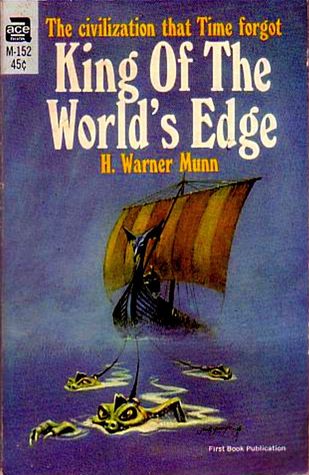 |
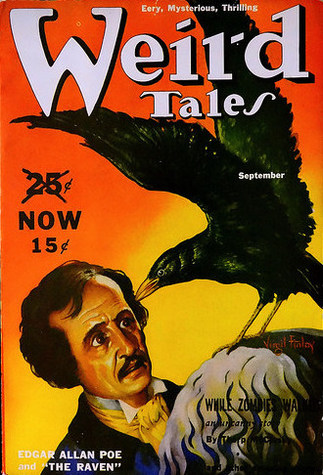 |
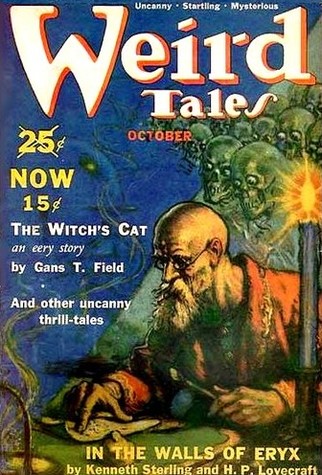 |
[Click any of the images for bigger versions.]
King of the World’s Edge was written by H. Warner Munn in the 1930’s and first published in serial form within the esteemed covers of Weird Tales, across four issues dating from September to December 1939.
It took until 1966 for the story to be collected as a complete novel and published by Ace Books (M-152). The paperback is 191 pages long, and contains a small picture at the introduction as well as a few maps. Copies are still reasonably priced in the second hand market. The cover was painted by Jack Gaughan and depicts a clinker built long ship being towed by some sort of aquatic creatures.
The back cover blurb reads:
They were a lonely, half starved band of adventurers who had been cast out of their homeland by hordes of invading marauders — and they came to an unknown world as strange, as fantastic, as wonder-packed as the legendary Atlantis. Here they encountered the dreaded fish-monsters of Piasa, and were captured by the savage legions of Miapan’s barbaric empire. But they escaped — and vowed to build a new civilization in the wilderness that would crush the tyrants of Miapan forever!
This continually exciting novel of strange worlds and fierce gods has long been rated alongside those of Burroughs and Merritt. Now at last it is available to modern readers — a tale that will ring in your memory!
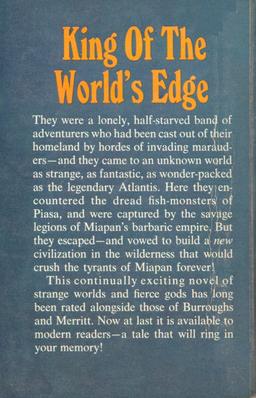 (H. Warner) Munn introduced the story through the eyes of a 20th century scholar of history who has come across a unique text, ostensibly discovered by a friend, who has requested he try to decipher it. This prelude is brief and the narrator does not insert himself much into the narrative, so whether you are one for this kind of introduction or not, it does not in my opinion detract from the story.
(H. Warner) Munn introduced the story through the eyes of a 20th century scholar of history who has come across a unique text, ostensibly discovered by a friend, who has requested he try to decipher it. This prelude is brief and the narrator does not insert himself much into the narrative, so whether you are one for this kind of introduction or not, it does not in my opinion detract from the story.
The novel relates the adventures leading up to and following the final battle of King Arthur and his knights. What I found interesting was that Munn basically established Arthur and his knights as the last vestiges of the Roman Empire in Britain. A trope well enough known these days, but I wonder how well it was received back in the 1930’s. Without making this a discussion of the Arthurian Cycle, the key is that one of the main characters is Merlin, or Myrdhinn to be more accurate.
Munn draws from one of my favorite Arthurian myths, wherein King Arthur and his closest knights are all mortally wounded. Myrdhinn places them inside a cave with an enchantment upon them that one day they will wake and usher in a new age of enlightenment.
That important task done, Myrdhinn turns to the last great Roman Centurion, Ventidius Varro, who is also the author of the historical account addressed to the Emperor of Rome, which Munn is subsequently deciphering to bring us this story. With no more influence in Britannia, an emperor who has forsaken them and a few Saxon refugees wanting to join forces, the punters decide to embark upon a voyage to a mythical land in the far west, beyond the known world. Handily, they have Arthur’s tin lined flagship to utilize on this voyage into the unknown.
I won’t ruin the surprises from there. Any reader with the mildest understanding of world geography can anticipate what comes next. They key is Munn, and his unique method of merging history, fantasy and myth!
Understand that the author has drawn on historical postulation and ideas that may now be seen as fact (or fiction), but in his time may have been akin to myth. As an outsider to North and Central American ancient history, I can only postulate as to whether certain peoples were meant to be proto Aztec, Mayan, Toltec or even Pueblo or Anasazi.
The story details the group’s trial and tribulations, defeats and victories as Ventidius Varro and his cohorts meet friends and enemies and in some way contribute to the rise of one civilization and the collapse of another. The bits of fantasy and “could have been” work well and quite frankly explain why H. Warner Munn is – albeit perhaps a late addition – a genuine “golden age of sword and sorcery alumnus.”
The Ship from Atlantis – by H. Warner Munn
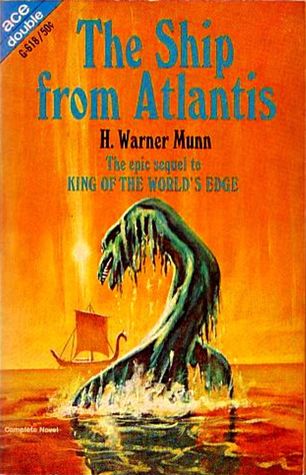 |
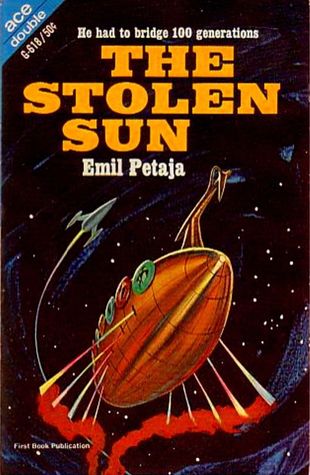 |
This novel was first published by Ace Books in 1967 as an Ace Double (G-618) paired with Emil Petaja’s The Stolen Sun. A direct sequel to King of the World’s Edge, The Ship from Atlantis was ostensibly written in 1941. When Donald A. Wollheim approached H Warner Munn to publish the first book, he picked up the sequel as well.
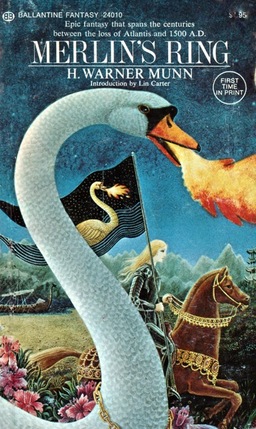 Most of the information I was able to find on the author points toward the pressures of life forcing writing to take a back seat. Only once he retired did he return to writing. This, accompanied by the fact that World War II was underway, may have been the reason The Ship from Atlantis took so long to see the light of day. Thankfully the astute Mr. Wollheim did publish it, as I found it really enjoyable.
Most of the information I was able to find on the author points toward the pressures of life forcing writing to take a back seat. Only once he retired did he return to writing. This, accompanied by the fact that World War II was underway, may have been the reason The Ship from Atlantis took so long to see the light of day. Thankfully the astute Mr. Wollheim did publish it, as I found it really enjoyable.
At only 117 pages it is a fast paced, action filled novel. The cover is once again painted by Jack Gaughan. The story details the adventures of Gwalchmai, son of Ventidius Varro and godson of Merlin, who departs the Americas to bring tidings to the Emperor of Rome. The misadventures start soon thereafter, as our poor hero is beset by one disaster after another. Munn cleverly uses one of these disasters to tie up a plot thread from King of the Worlds Edge.
Eventually finding himself becalmed and trapped upon the Sargasso Sea, Gwalchmai has to fight off thirst and worse before he encounters a fantastical ship – from Atlantis. I will not spoil the story with regards to the strange occupants of the ship, or the adventures they embark upon. Suffice is to say the tale is enjoyable and uses elements which I thought were quite imaginative.
The two books could as easily be read separately as together. I can recommend both as something refreshingly different, with unique takes and twists on recognizable myths and legends.
Both volumes were combined into one omnibus edition, Merlin’s Godson, published by Ballantine (later Del Rey) in 1976, with a cover by Darrell Sweet.
There was one additional novel in the series, Merlin’s Ring (1974), which I’ll discuss in a subsequent article.
The Stolen Sun — by Emil Petaja
The Ace Double edition of The Ship from Atlantis was paired with The Stolen Sun, part of Emil Petaja’s Kalevala cycle. The cover was again by Jack Gaughan. I’d never heard of Emil Petaja, but when I finished up The Ship from Atlantis, I dutifully flipped the book over and began reading this 136 page short novel.
The story started off in a recognizable science fiction manner, with a distant future starship pilot whose job is to destroy aggressive alien enemies. From there it takes a left turn into a spiral of weirdness.
I struggled a bit with it at first, but soon got used to it. It did help when I looked up the author on Wikipedia and discovered him to be of Finnish descent — and that The Kalevala is the Fin national heroic epic. Things started to fall into place, and soon I realized that Ukko was more than a humorous yet nasty little dwarf sidekick from 2000 AD Slainé comics.
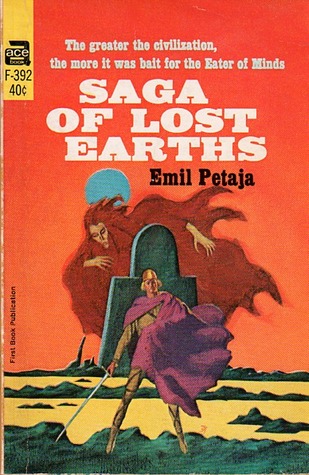 |
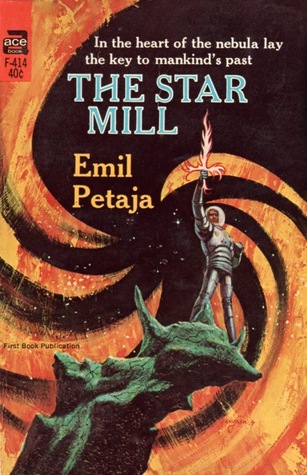 |
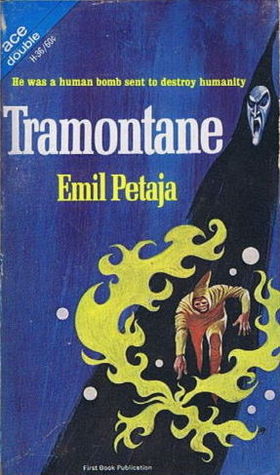 |
What I did not realize — and what the Ace Double never let on — was that The Stolen Sun was book three in a four book cycle based on The Kalevala. I only found out while researching this article. The novels are:
- Saga of Lost Earths (1966)
- The Star Mill (1966)
- The Stolen Sun (1967)
- Tramontane (1967)
Still, The Stolen Sun seems to stand alone pretty well. I was able to follow the plot and empathize with the plight of the people who look to the hero for salvation.
DAW Books reprinted all four novels in two omnibus editions in 1979, collecting Saga of Lost Earths and The Star Mill (books one and two) and The Stolen Sun and Tramontane (books three and four). I am intrigued, and I’ve added these to my wish list. I’m sure reading the entire series will prove enjoyable — and also informative of the unique culture of Finland, which is so different from its neighbors.
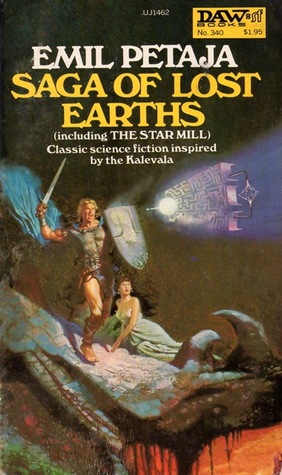 |
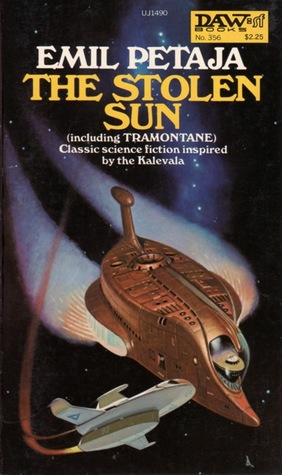 |
In terms of success, I suspect Mr. Petaja may have seen a bit more than Mr. Munn, simply based on how long Petaja’s books remained in print. Of course, this isn’t really a fair comparison, as Petaja wrote for much of his life, while Munn took a large hiatus before taking up the pen again late in life.
Our coverage of H. Warner Munn also includes:
Atlantis, Vikings, and the Hoards of Kubla Khan: Merlin’s Ring by H. Warner Munn: Part I by Tony Den
Werewolves, Ancient Alien Evil, and Babylonian Witches: Tales of the Werewolf Clan by H. Warner Munn by Christopher Paul Carey
Tony Den’s last article for Black Gate was Murray Leinster and the Moon.
Wow! What a gorgeous cover by the great Darrell Sweet! This makes me want to read MERLIN’S GODSON…thanks for the post!
Thanks John. My hope was to shed light on this often overlooked author, so from your comments I hope mission completed.
Good post. H Warner Munn is one of those authors I have always intended to read and never have. Amazon UK are offering “The Book of Munn or A Recipe for Roast Camel”, by H Warner Munn. As the cost is nearly £85, I will not be purchasing it but I am intrigued as to its contents. Anyone out there know what’s inside? Neil
I know I read Merlin’s Ring as part of my Ballantine Adult Fantasy read-through several years ago. Now I’m trying to remember if I read Godson or not.
Yeah, I like Munn’s books. I prefer Merlin’s Godson to Merlin’s Ring because I think the latter is a bit dry in stretches, whereas Gwalchmai’s adventures are much more fast-paced and vividly imagined, IMO.
I did luck into a dirt cheap copy of The Lost Legion not too long ago, but I have yet to get around to it. I’ve heard Munn did a pretty good werewolf series for Weird Tales but haven’t yet found any copies of that.
Correct he did what by appearance was a well received series of werewolf tales. The Werewolf of Ponkert seems to be the most recalled one. I too would like to obtain The Book of Munn and How to Cook a Camel. Also The Banner if Joan.
[…] The Brain-Stealers by by Francis Rufus Bellamy and Murray Leinster The Ship from Atlantis/ The Stolen Sun by H. Warner Munn and Emil Petaja Vulcan’s Hammer / The Skynappers by Philip K. Dick and […]